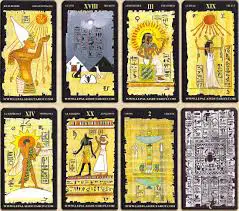Here are some facts about ancient Egyptian Tarot:
Tarot did not originate in ancient Egypt, despite claims to the contrary. In 1781, the French author Court de Gébelin referred to the Tarot as a book preserving the pure wisdom of ancient Egypt. This is the first written suggestion that occult wisdom had been encoded in the cards – in spite of the fact that they had already been in use for over 300 years.

It wasn’t until the height of France’s 18th century Enlightenment that tarot came to the fore in relation to Egyptian-styled initiations being introduced into the Rosicrucian and Masonic secret societies. France was home to a scholarly movement in search of the roots of language, believed to be a form of Hebrew, a remnant of the language of the gods codified in the Egyptian hieroglyphs.
Most modern Egyptian-styled tarot decks have evolved from these descriptions in Christian’s book. Arcana, from a root signifying “boxes,” was a word long used by magicians to mean “magical secrets.”
The cards are large, but the picture fills up most of the card, so it is very little in the way of the white border. When the book is referenced for an explanation, not only does it describe each card, and the significant symbols found, but the card meanings themselves are easily associated with the vivid imagery.
Each element in the card is explained in detail, including the colors, and associations of the ‘totem’ animals. The major arcana explores the myth of Osiris, using individual ‘scenes’ for the cards.
Another early appearance of the Egyptian pattern is found in a 1931 book by Woldemar von Uxkull, titled Die Einweihung in Alten Ägypten. These designs were the basis of a 1949 deck titled Schikowski Tarot(9) as well as a 1954 deck which accompanied the book Tarot der Eingeweihten by Joachim Winkelmann.
Clive Barrett
The book, Ancient Egyptian Tarot by Clive Barrett combines the myths and symbols of ancient Egypt with traditional tarot themes. Barrett compares the Major Arcana cards to the myth of the death and resurrection of Osiris.
Each card shows an image from Egyptian culture within a frame of hieroglyphs taken from the Egyptian Book of the Dead. The dimensions of the cards and the borders are designed according to the principles of sacred geometry. The set includes the companion book The Ancient Egyptian Tarot. In this book, Barrett explains the meaning and symbolism of each card with its esoteric correspondences.
